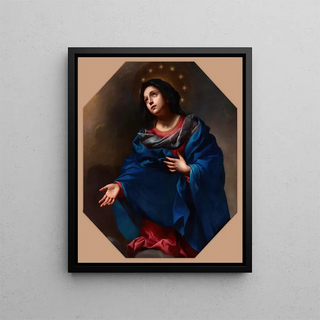Art print | Madonna in Glory - Carlo Dolci


View from behind

Frame (optional)
In the fascinating world of baroque art, the "Madone en gloire" by Carlo Dolci stands as an iconic masterpiece, captivating viewers and inspiring souls. This depiction of the Virgin Mary, surrounded by divine luminosity, transcends a simple painting to become a true spiritual experience. The artist, through his immense talent, manages to capture the very essence of faith and devotion, offering viewers an invitation to contemplate the beauty of the sacred. Through this art print, the magic of the original work is revealed, allowing each person to immerse themselves in a world where art and spirituality intertwine harmoniously.
Style and uniqueness of the work
The "Madone en gloire" is an ode to feminine beauty and maternal tenderness. Dolci, a master of detail and color, uses a delicate palette to create nuances that seem to vibrate under the light. The composition, carefully orchestrated, highlights the Virgin, whose radiant face expresses infinite serenity. The drapery of her robe, subtly crafted, evokes an ethereal lightness, while the background, sprinkled with luminous clouds, reinforces this sense of transcendence. Every element of the work is designed to evoke a deep emotion, a spiritual connection with the divine. Dolci's technique, combining precision and sensitivity, gives this piece a singularity that sets it apart within baroque art.
The artist and his influence
Carlo Dolci, born in Florence in the 17th century, was an artist who established himself through his unique style and his ability to blend beauty and spirituality. Trained in the workshop of great masters, he quickly developed a personal approach, characterized by meticulous attention to detail and a refined color palette. His influence is not limited to his era, as his works continue to inspire many contemporary artists. Through the "Madone en gloire," Dolci not only illustrates his exceptional talent but also his capacity to touch the human soul through art. His artistic vision makes him an essential figure of baroque, and his legacy

Matte finish

View from behind

Frame (optional)
In the fascinating world of baroque art, the "Madone en gloire" by Carlo Dolci stands as an iconic masterpiece, captivating viewers and inspiring souls. This depiction of the Virgin Mary, surrounded by divine luminosity, transcends a simple painting to become a true spiritual experience. The artist, through his immense talent, manages to capture the very essence of faith and devotion, offering viewers an invitation to contemplate the beauty of the sacred. Through this art print, the magic of the original work is revealed, allowing each person to immerse themselves in a world where art and spirituality intertwine harmoniously.
Style and uniqueness of the work
The "Madone en gloire" is an ode to feminine beauty and maternal tenderness. Dolci, a master of detail and color, uses a delicate palette to create nuances that seem to vibrate under the light. The composition, carefully orchestrated, highlights the Virgin, whose radiant face expresses infinite serenity. The drapery of her robe, subtly crafted, evokes an ethereal lightness, while the background, sprinkled with luminous clouds, reinforces this sense of transcendence. Every element of the work is designed to evoke a deep emotion, a spiritual connection with the divine. Dolci's technique, combining precision and sensitivity, gives this piece a singularity that sets it apart within baroque art.
The artist and his influence
Carlo Dolci, born in Florence in the 17th century, was an artist who established himself through his unique style and his ability to blend beauty and spirituality. Trained in the workshop of great masters, he quickly developed a personal approach, characterized by meticulous attention to detail and a refined color palette. His influence is not limited to his era, as his works continue to inspire many contemporary artists. Through the "Madone en gloire," Dolci not only illustrates his exceptional talent but also his capacity to touch the human soul through art. His artistic vision makes him an essential figure of baroque, and his legacy






